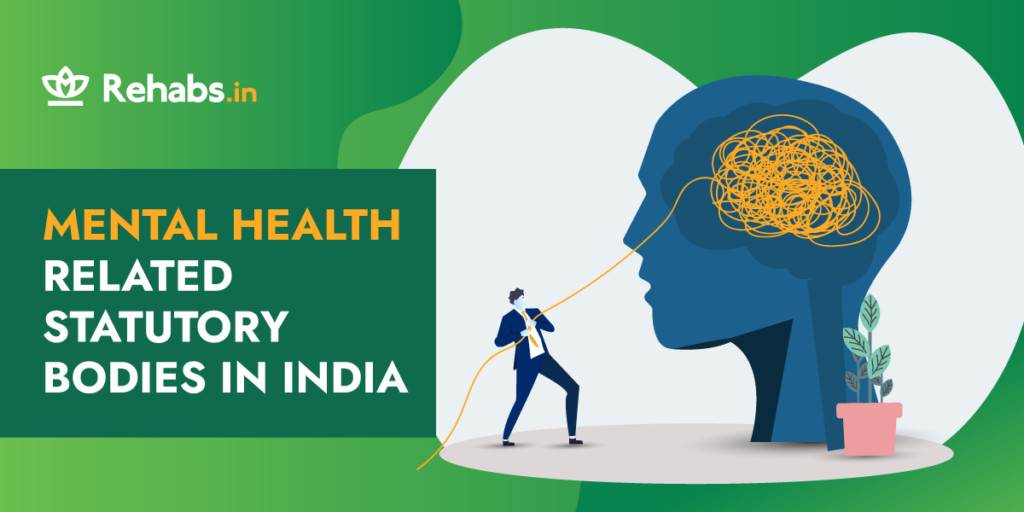Mental health-related statutory bodies in India

Is the mental health crisis now a pandemic growing within the Covid pandemic? The numbers certainly seem to say so.
According to a scientific brief by the World Health Organization (WHO), the global prevalence of anxiety and depression grew by a massive 25% in the first year of the Covid-19 pandemic. WHO estimates that 1 in every 4 people will have poor mental health or suffer from a mental illness at some point in their lives. “This is a wake-up call to all countries to pay more attention to mental health and do a better job of supporting their populations’ mental health”, according to WHO Director-General Dr Tedros Adhanom Ghebreyesus.
When it comes to mental health in India, the “Global prevalence and burden of depressive and anxiety disorders in 204 countries and territories in 2020 due to the COVID-19 pandemic” study, published in Lancet public health, estimates an increase of around 35% in anxiety and depression cases in India during the COVID-19 pandemic.
Moreover, a recent survey by India’s National Institute of Mental Health and Neurosciences (NIMHANS) shows that from the nearly 150 million Indians in need of mental health care services, fewer than 30 million are seeking treatment.
Yet, mental healthcare in India is now a right of every person by law. Section 18 of the MHA, 2017 states that “Every person shall have a right to access mental healthcare and treatment from mental health services run or funded by the appropriate Government” and that “the right to access mental healthcare and treatment shall mean mental health services of affordable cost, of good quality, available in sufficient quantity, accessible geographically, without discrimination on the basis of gender, sex, sexual orientation, religion, culture, caste, social or political beliefs, class, disability or any other basis and provided in a manner that is acceptable to persons with mental illness and their families and caregivers.”
WHO describes mental health as “a state of mental well-being that enables people to cope with the stresses of life, realise their abilities, learn well and work well, and contribute to their community. It is an integral component of health and well-being that underpins our individual and collective abilities to make decisions, build relationships and shape the world we live in.”
As India celebrates mental health awareness month in May, let’s take a look at the history of mental health in India and the key provisions for mental health made by the Indian government.
History of Mental Health in India: An Overview
In India, the oldest accounts of mental health disorders are found in two well-known Ayurvedic manuscripts, the Charaka Samhita by Charaka, and the Sushruta Samhita by Sushruta. Both these texts have formed the roots of modern Indian medicine.
The history of mental health in India is also closely linked to its mental health establishments and legislation. Mental health legislation in India has gone through various changes over the years since the Lunatic Removal Act, 1851, in British India ceased in 1891.
The India Lunacy Act of 1912 was the first law to govern mental health in Independent India. This act brought changes in the management of asylums, which were later renamed mental hospitals. However, a major pitfall of this act was that it focused on the protection of the public from patients with mental illness who were considered dangerous to society.
As the act neglected human rights and was focused mainly on custodial sentences, the Indian Psychiatric Society suggested a draft in 1950. But it was over three decades later, in May 1987, that the draft was given assent by the then President of India.
It was later implemented in 1993 as the Mental Health Act (MHA) 1987. The advantage of the MHA 1987 was its progressive definition of mental illness, placing emphasis not on custody but on treatment and patient care. It also revolved mainly around the need to protect human rights, guardianship, and the management of property of people with mental illness.
Criticism of MHA 1987 was mainly related to legalities involving licensing, admission and guardianship, as a result of which Mental Health Care Bill 2013, which was then passed as the MHA, 2017.
Statutory Mental Health Bodies in India: Roles & Responsibilities
India’s MHA 2017 empowers persons with mental illness. As per its opening statement, it is “An Act to provide for mental healthcare and services for persons with mental illness and to protect, promote and fulfil the rights of such persons during delivery of mental healthcare and services and for matters connected therewith or incidental thereto.”
After the enforcement of MHA 2017, all mental health professionals (MHPs) are legally bound to meet the provisions in the law. The MHPs are accountable to the following statutory bodies under the MHA 2017: CMHA, SMHA, and Mental Health Review Boards.
As per the MHA 2017, the law gives authority to the Central Mental Health Authority (CMHA) and the State Mental Health Authority (SMHA) under the central and state government, respectively, to carry out the necessary proceedings as per the act.
The functions of the CMHA include:
a) registering all mental health establishments under the control of the Central Government and maintaining a register of all mental health establishments in the country based on information provided by all SMHA of registered establishments and compile, update and publish (including online on the internet) a register of such establishments;
(b) developing quality and service provision norms for different types of mental health establishments under the Central Government;
(c) supervising all mental health establishments under the Central Government and receiving complaints about deficiencies in the provision of services;
(d) maintaining a national register of clinical psychologists, mental health nurses and psychiatric social workers based on information provided by all State Authorities of persons registered to work as mental health professionals for the purpose of this Act and publishing the list (including online on the internet) of such registered mental health professionals;
(e) training all persons, including law enforcement officials, mental health professionals and other health professionals, about the provisions and implementation of this Act;
(f) advising the Central Government on all matters relating to mental healthcare and services;
(g) discharging such other functions with respect to matters relating to mental health as the Central Government may decide: providing that the mental health establishments under the control of the Central Government, before the commencement of this Act, registered under the Mental Health Act, 1987 or any other law for the time being in force, shall be deemed to have been registered under the provisions of this Act and copy of such registration shall be furnished to the Central Authority.
Under the MHA 2017, the SMHA is required to constitute the Mental Health Review Board. The SMHA also protects the human rights of patients of all MHEs, or even those outside its geographic jurisdiction.
a) Registering, supervising, and maintaining a register of all MHEs;
(b) developing quality and service provision norms for such establishments;
(c) maintaining a register of MHPs;
(d) training law enforcement officials and MHPs on the provisions of the act;
(e) receiving complaints about deficiencies in the provision of services;
(f) advising the government on matters relating to mental health.
Mental Health Review Boards
Mental Health Review Boards are set up mostly in every district as per the recommendation of the CMHA/SMHA for a term of 5 years.
Functions of Mental Health Review Boards include:
a) registering and reviewing advance directives (ADs)
b) appointing nominated representative
c) deciding objections against MHP and MHE
d) deciding nondisclosure of persons with mental illness information
e) visiting jails
f) protecting human rights
Besides these bodies, another statutory body set up in 1993, the Rehabilitation Council of India (RCI), regulates and monitors services given to persons with disabilities, standardises syllabi, and maintains a Central Rehabilitation Register of all qualified professionals and personnel working in the field of Rehabilitation and Special Education.
Accessing Mental Health Care in India
In India, the lack of adequate mental health services and awareness of mental health still persists. According to a NIMHANS study in 2016, over 80% of people in India are unable to access treatment due to a dearth of capacity and proper infrastructure.
At present, there aren’t enough mental health professionals or mental health institutions in India to bridge the care gap. A WHO study reveals that India has only 0.29 psychiatrists per 100,000 population, significantly lower than the median of 0.3-0.5 in low-mid income countries and 9-11 in high-income countries.
Moreover, India has only 1.43 hospital beds available for mental health patients per 100,000 population, compared to a median of seven in low-income countries and 50 in high-income countries.
However, with awareness on the rise, there are several mental health foundations in India that are now available for mental health services in India.
If you or someone you know needs help to understand more about mental health statutory bodies in India and treatment, reach out to a mental health professional. You can browse our directory of treatment centres across India here.
Sources:
Reisinger Walker, Elizabeth; McGee, Robin E; Druss, Benjamin G (2015) Mortality in mental disorders and global disease burden implications: a systematic review and meta-analysis. JAMA Psychiatry. https://jamanetwork.com/journals/jamapsychiatry/fullarticle/2110027.
Firdosi, Muhammad Mudasir; Ahmad, Zulkarnain Z (2018) Mental health law in India: origins and proposed reforms. BJPsych International Mental Health Law Profile Collection. https://www.cambridge.org/core/journals/bjpsych-international/article/mental-health-law-in-india-origins-and-proposed-reforms/EE3BD2C213721E1FD267106A132CE7D7
Nizamie, S. Haque; Goyal, Nishant (2010) History of psychiatry in India. Indian Journal of Psychiatry. https://journals.lww.com/indianjpsychiatry/Fulltext/2010/52001/History_of_psychiatry_in_India.2.aspx
Prashanth, N. R.; Abraham, Shalu Elizabeth; Hongally, Chandrashekar; and Madhusudan, S. (2019) Dealing with statutory bodies under the Mental Healthcare Act 2017. Indian Journal of Psychiatry. https://journals.lww.com/indianjpsychiatry/Fulltext/2019/61004/Dealing_with_statutory_bodies_under_the_Mental.18.aspx
Daund, Muktesh; Sonavane, Sushma; Shrivastava, Amresh; Desousa, Avinash; Kumawat, Sanjay (2018) Mental Hospitals in India: Reforms for the future. Indian Journal of Psychiatry. https://journals.lww.com/indianjpsychiatry/Fulltext/2018/60002/Mental_Hospitals_in_India__Reforms_for_the_future.25.aspx
National Mental Health Programme. Directorate General of Health Services. https://dghs.gov.in/content/1350_3_NationalMentalHealthProgramme.aspx?format=Print#:~:text=Central%20Mental%20Health%20Authority%20(CMHA,and%20Professional%20Expenses%20(recurring
(April 2017) The Mental Healthcare Act, 2017 chrome-extension://efaidnbmnnnibpcajpcglclefindmkaj/https://egazette.nic.in/WriteReadData/2017/175248.pdf
(2022) COVID-19 pandemic triggers 25% increase in prevalence of anxiety and depression worldwide. World Health Organization.
(2001) The World Health Report 2001: Mental Disorders affect one in four people. World Health Organization.
(2021) Global prevalence and burden of depressive and anxiety disorders in 204 countries and territories in 2020 due to the COVID-19 pandemic. The Lancet. https://www.thelancet.com/journals/lancet/article/PIIS0140-6736(21)02143-7/fulltext
(2022) Mental Health. World Health Organization. https://www.who.int/news-room/fact-sheets/detail/mental-health-strengthening-our-response
Garg, Kabir; Kumar, C Naveen; Chandra, Prabha S (2019) Number of psychiatrists in India: Baby steps forward, but a long way to go. Indian Journal of Pyschiatry. https://www.ncbi.nlm.nih.gov/pmc/articles/PMC6341936/#ref3
Thippaiah, Srinagesh Mannekote; Nanjappa, Muralidhara Shankarapura; Bada Math, Suresh (2019) Suicide in India: A preventable epidemic Indian Journal of Medical Research. https://www.ncbi.nlm.nih.gov/pmc/articles/PMC6902368/
Prakash Singh, Om (2018) Closing treatment gap of mental disorders in India: Opportunity in new competency-based Medical Council of India curriculum. Indian Journal of Psychiatry. https://www.ncbi.nlm.nih.gov/pmc/articles/PMC6278227/#ref2














